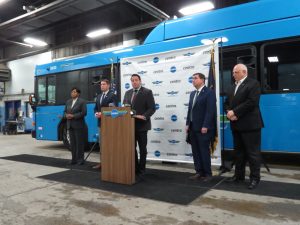Guns are not usually associated with typewriters considering their primary purposes are vastly different. However, Syracuse was an exception to that statement. Before the typewriter industry that made him his greatest fame and fortune, Lyman Cornelius Smith was a renown Syracuse gun manufacturer. L.C. Smith was born in Connecticut. At the age of nine, his […]
Get Instant Access to This Article
Become a Central New York Business Journal subscriber and get immediate access to all of our subscriber-only content and much more.
- Critical Central New York business news and analysis updated daily.
- Immediate access to all subscriber-only content on our website.
- Get a year's worth of the Print Edition of The Central New York Business Journal.
- Special Feature Publications such as the Book of Lists and Revitalize Greater Binghamton, Mohawk Valley, and Syracuse Magazines
Click here to purchase a paywall bypass link for this article.
Guns are not usually associated with typewriters considering their primary purposes are vastly different. However, Syracuse was an exception to that statement. Before the typewriter industry that made him his greatest fame and fortune, Lyman Cornelius Smith was a renown Syracuse gun manufacturer.
L.C. Smith was born in Connecticut. At the age of nine, his family moved to Lisle, N.Y. — located in Broome County, just north of Binghamton. L.C.’s father was extremely entrepreneurial, making a comfortable living as a general merchant, sawmill owner, and operator and tanner. L.C. Smith moved to New York City when he was age 23, but returned to Lisle penniless within two years.
His father then sent L.C. and his brother, Leroy, to Syracuse to set up a lumberyard on the corner of Burt and South Salina Streets. The lumber business was booming at the time due to the building requirements of the salt making industry. Soon after his arrival in Syracuse, L.C.’s hometown friend, W. H. Baker, convinced him that the future was in the manufacturing of guns, namely his Baker gun. Smith had recently made the acquaintance of Ms. Flora Burns, daughter of former Syracuse Mayor Peter Burns. Smith’s father-in-law had made his fortune in the saddlery business through his lucrative contract with the Union Army. L.C. and Flora eventually wed. Burns soon provided Smith with the necessary funds to purchase a gun-manufacturing plant located near the Armory off Walton Street in 1877. It had a large shooting gallery located on the roof for testing purposes. The company began with eight employees and three milling machines. The gun developed by Baker was a breech loading gun. It was a popular gun and the company grew significantly. Smith and Baker were partners with Smith’s brother Leroy and brother-in-law George Livermore. Another of L.C.’s brothers, Wilbert, also worked in the factory. Despite financial success, Baker realized that he could not work with L.C. and broke from the company. In late 1879, Baker dissolved the partnership and opened the Ithaca Gun Company along with Livermore and Leroy. Wilbert, remained as L.C.’s plant manager. Smith retained the rights to continue to manufacture guns originally patented by Baker.
 Smith moved his factory to a building located in the what was once the 100 block of S. Clinton St. The building had previously been the site of a carriage manufacturer. His factory took up most of the block. Gun sales began to drop off and Smith decided that he needed to develop and manufacture a more unique gun.
Smith moved his factory to a building located in the what was once the 100 block of S. Clinton St. The building had previously been the site of a carriage manufacturer. His factory took up most of the block. Gun sales began to drop off and Smith decided that he needed to develop and manufacture a more unique gun.
Fortunately, for L.C.’s sake, an individual by the name of Alexander T. Brown had been hired as a lathe operator in 1878. Brown was a gifted inventor and quickly designed and received a patent to manufacture a new cocking mechanism. This patent was followed by several others, leading to the design of a gun in 1884 that would become an American legend — the L.C. Smith gun, marketed as “the gun that never shoots loose and is a thing of beauty and a joy forever.” Trap shooting was a popular sport and the LC Smith gun received many accolades from trap shooters nationwide. In 1886, Brown patented a design for the hammerless gun. This gun was so advanced for its time that it remained unchanged for more than 60 years.
At its peak, the company employed 175 men, running close to 100 machines. Brown continued to make improvements to his gun patents while also designing and developing other projects including a design for a ‘visible’ typewriter (unlike original typewriter machines, typists were able to immediately see what they were typing). In 1888, L.C. Smith sold his gun manufacturing business to the Hunter Bros. company, which commenced moving the business to Fulton. Hunter took many of the craftsmen and most of the equipment once owned by Smith with him. The L.C. gun, nicknamed the “Sweet Elsie,” continued to be manufactured by Hunter Bros. and other companies for decades.
L.C. Smith and Alexander T. Brown then began their typewriter-company journey that lasted several decades — making millions of dollars due entirely to Smith’s financial acumen and Brown’s mechanical genius. Thanks to these gentlemen, Syracuse became the center of America’s typewriter manufacturing industry and eventually became known in many circles as “Typewriter City.”
Karen Y. Cooney is support services administrator at the Onondaga Historical Association (OHA) in Syracuse.




